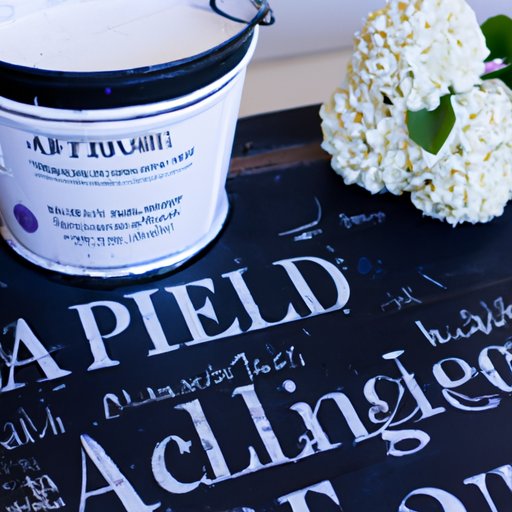I. Introduction
Chalk paint has gained immense popularity in the DIY world, thanks to its ability to transform any furniture piece into a shabby chic masterpiece. Homeowners, crafters, and DIY enthusiasts alike are raving about this versatile and easy-to-use paint. If you’ve never heard of chalk paint, or you’re curious about how it works, this article is your ultimate guide to everything you need to know.
II. Chalk Paint: The Trendy DIY Paint That Everyone Is Raving About
Chalk paint is a type of decorative paint that can be used on almost any surface. Unlike traditional paint, it doesn’t require sanding or priming before use. It also has a unique matte finish that creates a vintage, shabby chic look.
The popularity of chalk paint can be attributed to its versatility and ease of use. It adheres to almost any surface, including wood, plastic, metal, and even glass. With its quick drying time, one can have a completed furniture makeover in just a few hours.
III. A Beginner’s Guide to Chalk Paint: What You Need to Know
Before diving into your first chalk paint project, it’s important to prepare the surface appropriately. Firstly, use a cloth or sponge to remove any dirt, dust or grime from the furniture piece to be painted. Fill any visible cracks, holes or depressions with wood filler, and smoothen the surface. One can use fine-grit sandpaper to lightly buff furniture surfaces that are naturally smooth.
Chalk paint can be easily applied with a brush as it has a thick consistency, which means that it covers any brush strokes once the paint dries. Shaking the paint tin or using a stirrer rod help ensure that one gets an even consistency of paint while using it.
For an upgraded look, consider utilizing techniques like dry brushing, which utilizes a dry brush and pouncing, where you apply different layers in a specific order, for texture.
Common tools needed for chalk painting are paintbrushes, sandpaper, and a soft cloth. Have a clean water source nearby for washing brushes between uses and dampening your cloth.
IV. Transform Your Furniture with Chalk Paint: Tips and Tricks
The best part about chalk paint is how it can turn outdated furniture into eye-catching decor pieces that can uplift any space. One should consider the color of the paint, swatches should be tested on the furniture to guarantee you choose the best color that’ll compliment the surrounding area. For more character, pair light and dark colors. Not all furniture painted with chalk paint has to have just one color; adding a pop of color or a pattern can enhance the uniqueness of the furniture piece.
Distressing chalk paint can add modern and industrial themes to the décor. It will involve sanding off some layers of the paint from the corners of the furniture piece. Sandpaper abrasiveness can be controlled by doing it in circular motions in the same place or going deeper on particular areas, mostly the corners. Afterward, remember to clean the furniture with a damp cloth for an excellent finish.
For a creative spin, consider accenting your painted furniture with stencils and decoupage. One can use decoupage patterns on the drawers or add a stencil pattern on the surface of the furniture for an aesthetic look.
V. The History of Chalk Paint: From Annie Sloan to Today’s Top Brands
Chalk paint was first introduced by Annie Sloan in 1990, in the book “The Complete Book of Decorative Paint Techniques.” After the release of her book, Annie launched her brand, renaming the paint after herself and starting a sensation in DIY furniture painting. Chalk paint has since then become a staple paint in crafting and DIY circles. Numerous brands have adopted the formula, and there’s a broad range of paint colors and finishes to choose from.
As chalk paint grows in popularity, it has become a more versatile paint that can be used on walls aside from furniture. Some top brands also offer waxes and sealants specifically for chalk paint to ensure long-lasting durability and protection against the elements.
VI. Chalk Paint vs Regular Paint: Pros and Cons
Chalk paint is loved for its unique matte finish and ease of use. The paint’s opacity makes it highly pigmented, which means one coat of paint often covers the surface completely. One great thing is that it dries quickly enough for re-coats to be added in the same day. Its thick consistency also means that one doesn’t always need to apply a primer coat before painting.
However, chalk paint does come with some drawbacks. Its thickness contributes to a short lifespan of brushes. One also has to think of the protective finish for the furniture once chalk paint has dried, and it may chip or crack if not appropriately sealed. One may have to invest in waxes or sealants applicable for the chalk paint’s protection against wear and tear.
VII. Conclusion
Chalk paint can transform any piece of furniture or decor in your home, creating eye-catching and unique pieces that have a vintage, shabby chic vibe. When starting with chalk paint, it’s essential to prepare your furniture and choose the right applications for them. With a little creativity and motivation, you can create beautiful pieces that are unique and one-of-a-kind.
So, next time you plan on having a redo of your home, consider using chalk paint for an affordable and refreshing way to change the look of your furniture.
